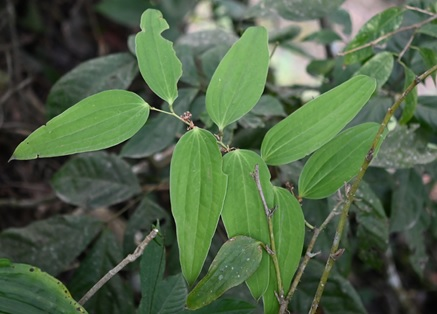The long-lost plant species, Smilax turbans, a wild counterpart of a plant that possesses anti-inflammatory properties and enhances the functioning of the immune system, has been rediscovered during a search in the pristine forests of Arunachal Pradesh. The rediscovery underlines the importance of preserving unique bio diverse ecosystems and offers scientists’ opportunity to learn more about the species. It can also lead to the development of new pharmaceuticals, herbal remedies, or agricultural commodities that could benefit human health and livelihoods.
The discovery which was made almost a century after its first collection, represents a wild counterpart of the renowned Ayurvedic therapeutic plant Chopchini (Smilax china), belonging to the family Smilacaceae), which is recognised for its capacity to purify the bloodstream, eliminate harmful substances, treat inflammatory diseases and enhance overall well-being.
All these characteristics along with beneficial effects on reproductive health and the gastrointestinal system render Chopchini a highly valuable botanical resource for traditional Ayurvedic therapy. Across the globe, there exists a total of approximately 262 distinct species, whereas, in India, they are represented by 39 species.
Among the 39 species, Smilax turbans, first came to light in the early 20th century when it was described by the scientists F.T. Wang & Tang, based on the specimens collected during 1911–1928 by the botanists I. H. Burkill, and F. Kingdon-Ward, during their explorations in Arunachal Pradesh. After its initial identification, the plant seemingly vanished from the scientific records and remained hidden from the world for an astonishing 95 years.
During recent exploratory endeavours aimed at locating the wild relatives of Chopchini in India, Dr. RK Choudhary, the leading scientist, and his doctoral student, Ms. Geetika Sukhramani, from Agharkar Research Institute, Pune, an autonomous institute of Department of Science and Technology (DST), successfully identified this species blooming in the secluded regions of Kurung Kumey District in Arunachal Pradesh. Notably, this discovery occurred approximately 500 km from its previously documented habitat.
The rediscovery of Smilax turbans is not only a scientific milestone but also holds immense ecological importance. The researchers will now explore the role of this native species, in the local ecosystem, its interaction with other flora and fauna. Furthermore, the findings could potentially have implications for medicinal research, as various Smilax species have been known for their therapeutic properties in traditional medicine. To protect the recently discovered plant from any risks and assure its long-term survival, a comprehensive report is being compiled for the forest department of Arunachal Pradesh. The report suggests ways of examining and preserving Smilax turbans within their indigenous environment while also conducting rigorous surveillance of its population dynamics and ecological interrelationships.
Dr. Ritesh Choudhary, the lead botanist of the expedition, expressed his sheer elation, saying, "Rediscovering Smilax turbans after almost a century is a remarkable achievement for the scientific community. This extraordinary plant which was neglected and underexplored , has long been considered one of the 'Holy Grails' of botanical rediscoveries, and our successful efforts are a testament to the significance of preserving biodiversity and conducting thorough explorations in remote regions."
The rediscovery of Smilax turbans serves as a reminder of the mysteries that still lie hidden in the world's most remote and biodiverse regions and the importance of preserving these unique ecosystems.
Publication link: - https://doi.org/10.11646/phytotaxa.609.2.4

Fig. 1. Smilax turbans Wang & Tang, in its natural habitat.






























